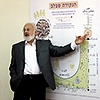Questions about Spiritual Work—66
 Question: We must attract the light of Hochma within reason. How can we check in the ten that we do it for true reason?
Question: We must attract the light of Hochma within reason. How can we check in the ten that we do it for true reason?
Answer: It is only with the help of the light of Hassadim when you want to bring everything to life with this light.
Question: What is the difference between attainment and knowledge?
Answer: When you are talking about full attainment or full knowledge, there is no difference. But when we go through the stages of spiritual attainment, there is a difference between attainment and knowledge.
Question: The sources say that there are many paths in the Torah. Does this mean that every soul has its own path? Or are there many different paths to the goal in Kabbalah?
Answer: No, in the end we must all connect and move along the same path to achieve complete correction.
Question: Is it possible to say that the ten in itself is a righteous man?
Answer: No, the ten must reach a state where they will be united and be called righteous. And at each degree, it will be like a different ten. So its every righteous person will always look different.
[323931]
From the Daily Kabbalah Lesson 1/16/24, Writings of Baal HaSulam “Why We Need to Extend Hochma”
Related Material:
Questions about Spiritual Work—65
Questions about Spiritual Work—64
Questions about Spiritual Work—63













